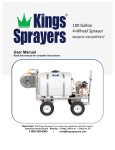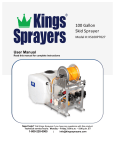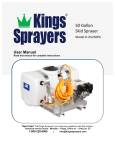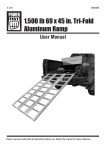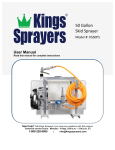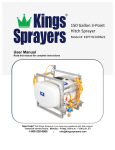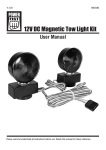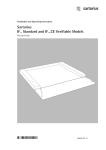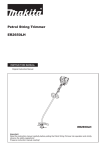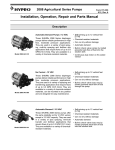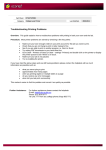Download 35 Gallon Skid Sprayer
Transcript
35 Gallon Skid Sprayer Model #: K35P150A User Manual Read this manual for complete instructions Need help? Call Kings Sprayers if you have any questions with this product. Technical service hours: Monday – Friday, 8:00 a.m. – 5:00 p.m. ET 1-800-228-0905 | [email protected] Model #: K35P150A Table of Contents Warranty .......................................................................................................................... 3 General Safety Information ........................................................................................... 3 Hazardous Substance Alert .......................................................................................... 4 Sprayer Components ..................................................................................................... 5 Getting Started ............................................................................................................... 6 Starting Your Sprayer for the First Time .............................................................................. 6 Shutting Down Your Sprayer ................................................................................................. 6 Troubleshooting Your Sprayer ..................................................................................... 7 2 Warranty 5 year frame / 5 year tank / 1 year parts and labor (limited to manufacturer defects) / 1 year pump (limited to manufacturer defects). The warranty will not apply to products that were improperly installed, misapplied, damaged, altered or incompatible with fluids or components. Kings Sprayers obligation under this warranty is limited to the repair or replacement of the product. All returns will be tested per factory criteria. Products found not defective (under the terms of this warranty) are subject to charges paid by the returnee for testing and packing of “tested good” non-warranty returns. No credit or labor allowances will be given for products returned as defective. Warranty replacement will be shipped at Kings Sprayers discretion. Kings Sprayers reserves the right to choose the method of transportation. Contact Kings Sprayers at 800-228-0905 to receive a Return Merchandise Authorization (RMA#) before returning any products. The RMA number should be clearly marked on the outside of the package. Kings Sprayers shall not be liable for freight damage incurred during shipping. All products returned for warranty work should be sent shipping charges prepaid. General Safety Information If unsure of the chemical compatibility or the motors intended design, please call Kings Sprayers for assistance. Intermittent duty is defined as: Operated and/or frequently started within a period of time that does not cause the motor to reach its maximum thermal limits. If the maximum thermal limit is reached, the motor must be allowed to return to ambient temperature before resuming operation. DO NOT use to pump flammable liquids. Never operate the pump in an explosive environment. Arcing from the motor brushes, switch or excessive heat from an improperly cycled motor may cause an explosion. DO NOT assume fluid compatibility. If the fluid is improperly matched to the pump’s elastomers, a leak may occur. Pumps used to transfer hazardous or hot (maximum temperature 170°F [76°C] Viton only) chemicals must be in a ventilated area to guard against the possibility of injury due to harmful or explosive liquid/vapors. DO NOT operate the pump at pressures which cause the motor to exceed the amp rating indicated on the nameplate. Various pump models are equipped with thermal breakers to interrupt operation due to excessive heat. Once the temperature of the motor is within proper limits it will automatically reset and the pump will start operation without warning. DO NOT locate the motor near low temperature plastics or combustible materials. The surface temperature of the motor may exceed 250°F (121°C). To prevent electrical shock, disconnect power before initiating any work. In the case of pump failure, the motor housing and/or the fluid being pumped may carry high voltage to components normally considered safe. The pressure switch reacts to outlet pressure, and interrupts power at a preset shut-off pressure, indicated on the pump label. When outlet pressure drops below a predetermined limit, the switch will close and the pump will operate until the shut-off (high) pressure is reached again. Improper adjustment of the pressure switch may cause severe overload or premature failure. Failures due to improper adjustment of the pressure switch setting will not be covered under warranty. The pump should be located in an area that is dry and provides adequate ventilation. If mounted within an enclosure, provisions to cool the motor may be necessary. Heat sinks, which attach to the motor, are available if increased heat dissipation is 3 necessary.The pump may be mounted in any position. However, if mounting the pump vertically, the pump head should be in the down position. Kings Sprayers does not recommend the use of metal fittings to plumb the inlet/outlet ports on poly pump heads. In some cases, the ports may require a suitable thread sealer applied sparingly. Use caution when using sealers or Teflon tape as they may act as a lubricant, causing cracked housings or stripped threads due to over tightening. Do not overtighten. Electrical wiring should be performed by a qualified electrician, in accordance with all local electrical codes. Improper duty cycle and/or rapid start/stop conditions may cause internal thermal breaker (if equipped) to trip, or can result in premature motor failure due to excessive heat. Pumps should be on a dedicated (individual) circuit, controlled with a double pole switch (UL/C-UL certified) rated at, or above, the fuse ampere indicated by the pump motor label. Depending on the distance from the pump, and ampere loaded on the circuit, wires may need to be heavier than indicated. The following chemicals should never be put through any pump: • • • • • • Gasoline (Petrol) or Diesel Fuel Kerosene/Kerosine (Paraffin) Ceramic Slurries Sewage Potable Water Abrasive Fluids Only authorized operators having the knowledge and skill necessary to safely use the pump, or any equipment the pump is connected to, may run the pump.When handling pumps, wear steeltoed shoes and protective gloves in order to protect the feet in the event the pump is dropped and protect the hands from chemicals or any sharp surfaces on the pump. When spraying manually, chemical-resistant facemasks and clothing should be worn to prevent any chemicals from coming into contact with the skin or being inhaled and always spray downwind from yourself as long as the sprayed chemical will not drift into the vicinity of other people. Never leave wires or plumbing components where they can be a tripping hazard or become entangled in a moving component. All maintenance should be done when machinery is stationary and has been isolated from its energy sources. It is dangerous to perform maintenance while machinery is still connected to its power source. Machinery should be isolated from its electrical, hydraulic, shaft driven or gas engine power source. Be sure to release all pressure from the system before performing any sort of maintenance on a pump. Hazardous Substance Alert Any hazardous liquids should be disposed of in a manner which complies with local and national regulations. Never dump fluids onto the ground. Never store pumps containing hazardous chemicals. Always drain and flush pump before servicing or disassembling for any reason. Always drain and flush pump prior to returning unit for repair. Before returning pump for service/repair, drain out all liquids and flush unit with neutralizing liquid. Then, drain the pump. Attach tag or include written notice certifying that this has been done. Please note that it is illegal to ship or transport any hazardous chemicals without United States Environmental Protection Agency Licensing. 4 Sprayer Components Figure 1: Side View 30’ clear braid hose Adjustable spray tip Two pole connector for 12V power source Pressure gauge to calibrate when spraying On/Off Ball valve for agitation Figure 2: Detailed View 5 Getting Started Starting Your Sprayer for the First Time 1. Ensure all unnecessary personnel are clear of the area. 2. For initial testing, it is recommended to start with clean water instead of chemicals to confirm the system and plumbing components are leak free. 3. Ensure there is fluid in the tank and supply line. 4. Check line strainer for debris or clogs and remove if any found. 5. Check all plumbing connections to ensure tightness. 6. Ensure all valves and regulators are set to the desired setting and working properly. 7. Ensure all hoses are positioned properly and undamaged. 8. Follow the next steps on starting the sprayer. 9. Plug the pump into a 12V power source. Note: The pump will only run when the spray gun is in use. 10. Adjust the spray gun by rotating the gray nozzle at the end. It is fully adjustable from a jet, to a cone, to a full mist. 11. Lock the spray handle by flipping the white switch. 12. To turn on the agitator, flip the black switch. Note: The pressure will drop when the agitator is engaged. Shutting Down Your Sprayer 1. Shut sprayer down using the outlined steps. 2. Disconnect pump from power source. 3. If pump will not be used for several hours flush your system to prolong the life of the components. For a step-by-step video guide, visit the Sprayer Depot YouTube Channel to watch instructional videos on a variety of topics. Tune in by visiting http://YouTube.com/SprayerDepot. 6 Troubleshooting Your Sprayer Symptom Pump will not start Possible Reason Blown fuse or breaker Improper voltage Pressure switch Open or grounded circuit Locked drive assembly Pump will not prime Out of product Clogged strainer Vacuum leak Restricted inlet/outlet tube Debris in pump valves Improper voltage Cracked pump housing Leaks from pump head or switch Loose screws at switch or pump head Ruptured diaphragm Punctured diaphragm Pump will not turn off Closed output line / leak Air trapped in outlet line or pump head Incorrect voltage Inlet/outlet valves are clogged or swollen Loose drive assembly or pump head screws Pressure switch misadjusted/malfunction Correction Check fuse or breaker Check for correct voltage (+/-10%) and electrical connections Check pressure switch operation and correct voltage at switch or motor wires (as equipped) Rectifier or motor for open or grounded circuit Check for locked drive assembly Check product level Make sure strainer is free of debris Check inlet tubing/plumbing; severe vacuum leak Inlet/outlet tube severely restricted (kinked) For debris in pump inlet/outlet valves Proper voltage with the pump operating (+/-10%) Check pump housing for cracks Check for loose screws at switch or pump head Check switch diaphragm ruptured or pinched Check for punctured diaphragm if fluid is present at bottom drain holes Check output line closed and no leaks Check for air trapped in outlet line or pump head Check for correct voltage to pump (+/-10%) Check inlet/outlet valves for debris or swelling Check for loose drive assembly or pump head screws Check pressure switch operation/adjustments (refer to S/B #1031 for proper differential and pressure adjustment procedure) 7 Noisy / rough operation Mounting feet are compressed too tightly Loose pump head or drive screws Flexible mounting surface Rigid pipe Check for mounting feet that are compressed too tight Check for loose pump head or drive screws Check the mounting surface to see if it multiplies noise (flexible) Check to see if the pump is plumbed with rigid pipe causing noise transmission 8








